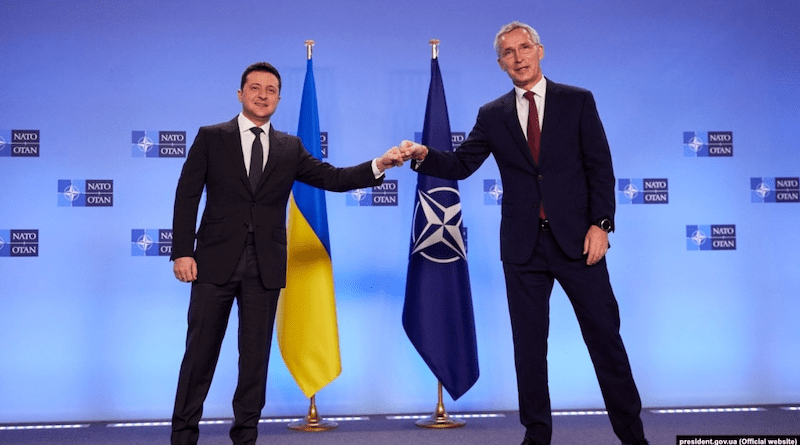The Ukraine War: Recent Russian Airstrikes And NATO’s Response – Analysis
By Observer Research Foundation
By Aditya Bhan
In what has been described as the most widespread air attacks since the start of the war in Ukraine, Moscow has targeted Ukraine’s power grid ahead of winter. In a candid admission made recently, Ukraine’s President Volodymyr Zelensky acknowledged that the Russian strikes had destroyed about 30 percent of his country’s power stations in one week. However, more recent reports suggest that the relentless attacks have damaged up to 40 percent of the nation’s grid.
President Zelensky has previously described Moscow’s motivation behind targeting Ukraine’s energy network in terms of the former’s intention to sever Ukrainian electricity exports to Europe. In September, referring to Russian attacks which left hundreds of thousands of Ukrainian citizens without electricity, President Zelensky had claimed that most of these strikes were carried out in desperation as a response to Moscow’s defeat in Kharkiv Oblast. He had stated that “they (the Russian armed forces) can’t defeat our heroes on the battlefield, and that’s why Russia is directing its vile strikes at civilian infrastructure”. More recent reports, including in some sections of the Western media, have claimed far higher numbers of Ukrainian residents facing power blackouts, with over a million people living without electricity.
Kyiv’s pleas
The scale of devastation faced by Ukraine’s power infrastructure within a short period attests to the success of Russia’s attacks. The effectiveness of the attacks can also be gauged from Kyiv’s desperate appeals to North Atlantic Treaty Organisation (NATO) countries for air defence systems to counter Russian air strikes.
In yet another desperate plea in October, President Zelensky had appealed to affluent Western countries to assist Kyiv in creating an “air shield”. Zelensky had said to the G7 group of wealthy countries that millions of Ukrainians would be grateful for fending off Russian aerial attacks and warned that Russia continued to possess the scope for further escalation. On the other hand, Russia’s President Vladimir Putin blamed Ukraine for the (Kerch Strait) bridge blast and warned of “severe” responses to any further attacks.
Kamikaze drones
Reports have emerged of swarms of so-called kamikaze or suicide drones having been unleashed by Moscow on Ukrainian cities as part of the recent offensive campaign against Ukraine, with the agile systems providing an inexpensive solution to Russian forces aiming to evade or overwhelm Ukrainian air defences. With about 200 such munitions available for the cost of a single cruise missile, it is no wonder that these tactical systems are being favoured by Russian battlefield commanders. Costing around US$20,000 a piece, compared to a cruise missile worth more than US$4 million, their deployment has heightened concerns that Russia has embarked on a brutal new chapter in its invasion of Ukraine.
Application of suicide drones have gained currency after the recent appointment of Sergey Surovikin, nicknamed “General Armageddon”, as the new commander-in-chief of all Russian forces in Ukraine. Incidentally, his ascendency coincided with a new surge of drone strikes, including the first prominent attack on Kyiv for many months.
NATO’s response
While Kyiv has identified the procurement of air defence systems as its number one priority, NATO countries are struggling to meet Ukraine’s requirements for enhanced security against Russian air and missile strikes. As things stand, Germany has provided only one of its four pledged Iris-T SLM modern air defence systems to Ukraine, whereas United States (US) President Joe Biden has committed to continue supplying contemporary air defence systems after talks with President Zelensky.
Western officials concur on the requirement for increased air defence for Ukraine and have expressed their willingness to assist, but claim that obtaining these systems expeditiously poses a challenge. The US and other countries are trying to identify systems that could be transferred, despite facing production shortages and depleted stockpiles. While some units have already been supplied to Kyiv, a lack of requisite production capacity is impeding further supplies especially because certain NATO allies are years behind in their own quest for air defence systems.
NATO countries such as Poland and the United Kingdom (UK) have supplied different air defence systems to Ukraine since the beginning of the war, from hand-held missile launchers to more complex truck-mounted platforms, creating a largely haphazard melange rather than an integrated grid of security along with Ukraine’s own post-Soviet systems like the S-300. The US has also pledged to supply two of its state-of-the-art National Advanced Surface-to-Air Missile Systems (NASAMS) in the next two months, and a further six that will arrive over a longer period. However, NATO Secretary-General Jens Stoltenberg has said that while “recent announcements by allies to provide more advanced air defence systems” were welcome, he was eagerly awaiting additional deliveries.
Outlook
With winter fast closing in on the battlefields of Ukraine, time is running out for Kyiv to put in place an effective air defence shield to protect its energy infrastructure from relentless Russian airstrikes and missile attacks. The inexpensive suicide drones now fielded by Russian forces have greatly increased their ability to sustain their bombardments for longer durations, without straining their remaining stockpiles of cruise missiles and more sophisticated and expensive weaponry, while also minimising the risk to Russian pilots and manned fighter aircraft.
Notwithstanding the recent Russian retreat from Kherson, there is ultimately no substitute for tangible Western support for Ukrainian troops on the battlefield, and in terms of a network of protective armaments defending the country’s critical infrastructure. However, the grossly inadequate NATO stockpile of air defence systems and production shortages do not inspire confidence regarding the Western alliance’s ability to bail Ukraine out of its dire situation over the foreseeable future.
Views expressed are personal.

